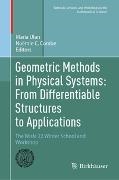Read more
This book presents selected lectures from the Wisła 22 Winter School and Workshop organized by the Baltic Institute of Mathematics that illustrate the power of geometric methods in understanding complex physical systems. Chapters progress from foundational mathematical structures to concrete applications in fluid dynamics and mechanical systems, highlighting the profound connection between differential geometry and physical phenomena.
The first chapter investigates differentiable structures on a non-Hausdorff line with two origins, setting the stage for the applications that follow. The next chapter transitions to fluid mechanics through a study of generalized geometry in two-dimensional incompressible fluid flows, establishing the mathematical framework needed for analyzing fluid systems through geometric lenses. Building on these foundations, the third chapter expands the perspective with a comprehensive treatment of nonlinear differential equations in fluid mechanics, utilizing concepts from contact and symplectic geometry to illuminate singular properties of fluid dynamics solutions. Finally, the fourth chapter demonstrates how geometric methods extend beyond fluid mechanics to mechanical systems with nonholonomic constraints, revealing how geometric formulations can address challenging phenomena like discontinuities, collisions, and the counterintuitive stabilization of inverted pendulums.
Geometric Methods in Physical Systems is ideal for graduate students and researchers working in these areas. A basic understanding of differential geometry and mathematical analysis is assumed.
List of contents
Classification of differentiable structures on the non-Hausdorff line with two origins.- Generalized Geometry of 2D Incompressible Fluid Flows.- Nonlinear differential equations of fluid mechanics: symmetries, integrability, singularities.
Summary
This book presents selected lectures from the Wisła 22 Winter School and Workshop organized by the Baltic Institute of Mathematics that illustrate the power of geometric methods in understanding complex physical systems. Chapters progress from foundational mathematical structures to concrete applications in fluid dynamics and mechanical systems, highlighting the profound connection between differential geometry and physical phenomena.
The first chapter investigates differentiable structures on a non-Hausdorff line with two origins, setting the stage for the applications that follow. The next chapter transitions to fluid mechanics through a study of generalized geometry in two-dimensional incompressible fluid flows, establishing the mathematical framework needed for analyzing fluid systems through geometric lenses. Building on these foundations, the third chapter expands the perspective with a comprehensive treatment of nonlinear differential equations in fluid mechanics, utilizing concepts from contact and symplectic geometry to illuminate singular properties of fluid dynamics solutions. Finally, the fourth chapter demonstrates how geometric methods extend beyond fluid mechanics to mechanical systems with nonholonomic constraints, revealing how geometric formulations can address challenging phenomena like discontinuities, collisions, and the counterintuitive stabilization of inverted pendulums.
Geometric Methods in Physical Systems is ideal for graduate students and researchers working in these areas. A basic understanding of differential geometry and mathematical analysis is assumed.

